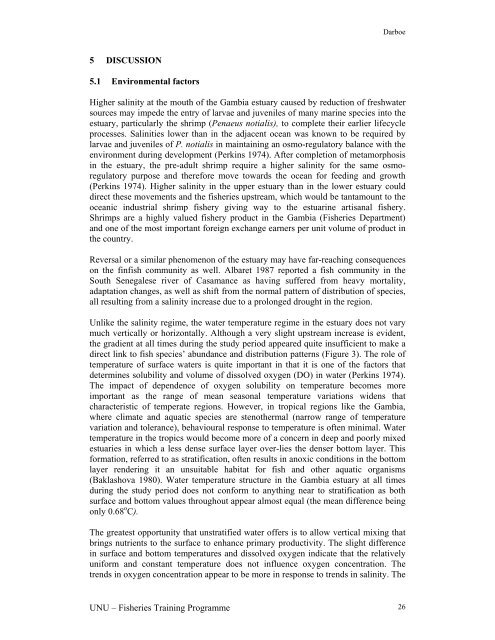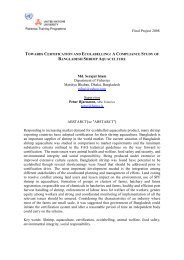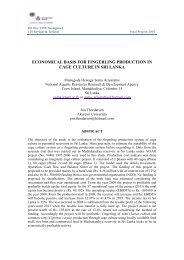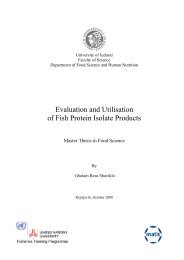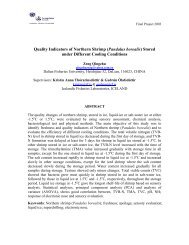Fish species abundance and distribution in The Gambia estuary
Fish species abundance and distribution in The Gambia estuary
Fish species abundance and distribution in The Gambia estuary
You also want an ePaper? Increase the reach of your titles
YUMPU automatically turns print PDFs into web optimized ePapers that Google loves.
Darboe5 DISCUSSION5.1 Environmental factorsHigher sal<strong>in</strong>ity at the mouth of the <strong>Gambia</strong> <strong>estuary</strong> caused by reduction of freshwatersources may impede the entry of larvae <strong>and</strong> juveniles of many mar<strong>in</strong>e <strong>species</strong> <strong>in</strong>to the<strong>estuary</strong>, particularly the shrimp (Penaeus notialis), to complete their earlier lifecycleprocesses. Sal<strong>in</strong>ities lower than <strong>in</strong> the adjacent ocean was known to be required bylarvae <strong>and</strong> juveniles of P. notialis <strong>in</strong> ma<strong>in</strong>ta<strong>in</strong><strong>in</strong>g an osmo-regulatory balance with theenvironment dur<strong>in</strong>g development (Perk<strong>in</strong>s 1974). After completion of metamorphosis<strong>in</strong> the <strong>estuary</strong>, the pre-adult shrimp require a higher sal<strong>in</strong>ity for the same osmoregulatorypurpose <strong>and</strong> therefore move towards the ocean for feed<strong>in</strong>g <strong>and</strong> growth(Perk<strong>in</strong>s 1974). Higher sal<strong>in</strong>ity <strong>in</strong> the upper <strong>estuary</strong> than <strong>in</strong> the lower <strong>estuary</strong> coulddirect these movements <strong>and</strong> the fisheries upstream, which would be tantamount to theoceanic <strong>in</strong>dustrial shrimp fishery giv<strong>in</strong>g way to the estuar<strong>in</strong>e artisanal fishery.Shrimps are a highly valued fishery product <strong>in</strong> the <strong>Gambia</strong> (<strong>Fish</strong>eries Department)<strong>and</strong> one of the most important foreign exchange earners per unit volume of product <strong>in</strong>the country.Reversal or a similar phenomenon of the <strong>estuary</strong> may have far-reach<strong>in</strong>g consequenceson the f<strong>in</strong>fish community as well. Albaret 1987 reported a fish community <strong>in</strong> theSouth Senegalese river of Casamance as hav<strong>in</strong>g suffered from heavy mortality,adaptation changes, as well as shift from the normal pattern of <strong>distribution</strong> of <strong>species</strong>,all result<strong>in</strong>g from a sal<strong>in</strong>ity <strong>in</strong>crease due to a prolonged drought <strong>in</strong> the region.Unlike the sal<strong>in</strong>ity regime, the water temperature regime <strong>in</strong> the <strong>estuary</strong> does not varymuch vertically or horizontally. Although a very slight upstream <strong>in</strong>crease is evident,the gradient at all times dur<strong>in</strong>g the study period appeared quite <strong>in</strong>sufficient to make adirect l<strong>in</strong>k to fish <strong>species</strong>’ <strong>abundance</strong> <strong>and</strong> <strong>distribution</strong> patterns (Figure 3). <strong>The</strong> role oftemperature of surface waters is quite important <strong>in</strong> that it is one of the factors thatdeterm<strong>in</strong>es solubility <strong>and</strong> volume of dissolved oxygen (DO) <strong>in</strong> water (Perk<strong>in</strong>s 1974).<strong>The</strong> impact of dependence of oxygen solubility on temperature becomes moreimportant as the range of mean seasonal temperature variations widens thatcharacteristic of temperate regions. However, <strong>in</strong> tropical regions like the <strong>Gambia</strong>,where climate <strong>and</strong> aquatic <strong>species</strong> are stenothermal (narrow range of temperaturevariation <strong>and</strong> tolerance), behavioural response to temperature is often m<strong>in</strong>imal. Watertemperature <strong>in</strong> the tropics would become more of a concern <strong>in</strong> deep <strong>and</strong> poorly mixedestuaries <strong>in</strong> which a less dense surface layer over-lies the denser bottom layer. Thisformation, referred to as stratification, often results <strong>in</strong> anoxic conditions <strong>in</strong> the bottomlayer render<strong>in</strong>g it an unsuitable habitat for fish <strong>and</strong> other aquatic organisms(Baklashova 1980). Water temperature structure <strong>in</strong> the <strong>Gambia</strong> <strong>estuary</strong> at all timesdur<strong>in</strong>g the study period does not conform to anyth<strong>in</strong>g near to stratification as bothsurface <strong>and</strong> bottom values throughout appear almost equal (the mean difference be<strong>in</strong>gonly 0.68 o C).<strong>The</strong> greatest opportunity that unstratified water offers is to allow vertical mix<strong>in</strong>g thatbr<strong>in</strong>gs nutrients to the surface to enhance primary productivity. <strong>The</strong> slight difference<strong>in</strong> surface <strong>and</strong> bottom temperatures <strong>and</strong> dissolved oxygen <strong>in</strong>dicate that the relativelyuniform <strong>and</strong> constant temperature does not <strong>in</strong>fluence oxygen concentration. <strong>The</strong>trends <strong>in</strong> oxygen concentration appear to be more <strong>in</strong> response to trends <strong>in</strong> sal<strong>in</strong>ity. <strong>The</strong>UNU – <strong>Fish</strong>eries Tra<strong>in</strong><strong>in</strong>g Programme 26


